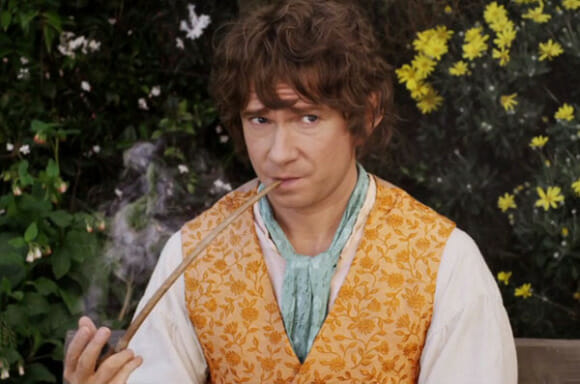
There’s a particular species of unease, a unique form of negative anticipation, generated when a beloved book is made into a film. The more “classic” the book, the greater the unease. This is hardly some irrational, hard-to-explain reaction—Hollywood whiffs more often than it makes solid contact, and more often than not it turns around and beats the source material into a bloody, unrecognizable pulp. Thus, in this film-saturated time, if you’re old enough to love a book, you’re old enough to have looked on in horror as some beloved classic has been thoroughly defiled by a film adaptation. Due to the much greater demands on visuals and special effects, this is especially true when it comes to fantasy and speculative fiction. Good Jane Austen adaptations can be found around every corner; H.P. Lovecraft and Philip K. Dick are still waiting for someone to strike true. (Though, granted, when it comes to Dick, the misses have yielded some classics.)
For this reason, Peter Jackson’s adaptation of J.R.R. Tolkien’s Lord of the Rings trilogy was as memorable for the initial gale-force sigh of relief it elicited from fans as for all the lucre, awards and merchandise that followed. After all, thanks to Jackson, Fran Walsh, Philippa Boyens, cast and crew, the world that was brought to life, the themes that were introduced and the story that was told were closer to the letter and spirit of the source material than anyone would have thought possible. Not surprisingly, the news that Jackson would be taking over the directing reins from Guillermo del Toro for LotR’s precursor, The Hobbit, fans rejoiced—Middle Earth would stay the same!
And it has, pretty much. For many, The Hobbit: An Unexpected Journey will provide a welcome return to the lands of New Zeal-I mean, Middle Earth. Though some may quibble over a lack of tonal and thematic distinction between the respective source material (heroically epic LotR versus the more whimsical, fairy tale-ish Hobbit), the Oscar-winning production design of Jackson and crew is refreshingly consistent. From the first few strains of Howard Shore’s soundtrack, it’s good to be back.
Plenty of familiar faces await—Frodo (Elijah Wood) and Old Bilbo (Ian Holm) via cameo; Galadriel (Cate Blanchett), Saruman (Christopher Lee) and Elrond (Hugo Weaving) for potentially lengthier roles in the sequels; and of course, Ian McKellen’s Gandalf, here for an extended stay. Joining them are Martin Freeman as a young Bilbo and thirteen actors, mostly unrecognizable beneath the dwarf-ness of it all (which should at least help avoid any pesky type-casting).
Much as with LotR, the casting is a strength. As the diffident Bilbo, Freeman seems immediately familiar and comfortable in the role. Richard Armitage brings an authority and somber presence to the role of Thorin Oakenshield that is crucial to the story that will follow. The rest of the company are distinguishable enough in dialogue and appearance to ensure an audience will know them by look and behavior, if not name, by film’s end.
More importantly, this first installment allays another fear unique to this second delving into Tolkein’s world. Unlike the LotR trilogy, in which the original material of three large books was condensed down to fit into three (still very long) films, The Hobbit is a small book with smaller themes being stretched to three. Instead of worrying about what or who would be left out (oh, Tom Bombadil!) with The Hobbit, it’s a question of “What will they add?” Initially, at least, the “filler” is pretty filling. An opening sequence providing the back story of the dwarven kingdom of Erebor’s rise and fall is riveting, as is a flashback to Thorin’s battlefield bravery during a failed attempt to re-occupy Moria. (All in all, it was a rough few years for dwarvenkind.)
For all the unique obstacles that Jackson surmounts, The Hobbit falters most in some of the most ubiquitous of cinematic challenges: pacing and realism. (Don’t snicker on the latter—the fantastic works best when the mundane is consistent and recognizable.)
The pacing issues mostly center on a string of hyper-kinetic action sequences, which are stretched and heightened past the breaking point of even fantasy credulity. Whether it’s thirteen dwarves clinging to absurdly narrow paths on moving and shattering cliff faces, or thirteen dwarves fleeing from the goblin horde of Chief Chin Wattle (not his real name, but damn if I could take my eyes off it), The Hobbit has a few too many unnecessarily over-clocked, “Not one dwarf fell off that!?” moments. The worst transgression, by far, is saved for last, thanks to a jarringly contrived trees-like-dominos sequence. It’s as if a scene in which our heroes are being attacked by, and then rescued from, orcs and monstrous wolves was deemed somehow lacking in spectacle. In a film with so many subtle things done so well, it’s a bad idea, badly executed, and most aggravating of all, completely unnecessary.
The CGI is convincing in its more sedate moments—the scenery enhancement, the trolls, Gollum’s cave—but becomes less so the more frantic the pace. (The less said about Radagast the Brown and his sled of little bunny foo foos, the better.)
That said, the bothersome aspects of The Hobbit won’t overwhelm the thrill felt by many (maybe most?) of finally seeing some of the fantasy genre’s most iconic scenes brought to life. The initial meal at Bilbo’s, the troll encounter, and, of course, Bilbo’s first, fateful meeting with Andy Serkis’ exquisitely realized Gollum—they are worth the price of admission.
But it’s a closer call than it should have been.
Director: Peter Jackson
Writer: Fran Walsh, Philippa Boyens, Peter Jackson & Guillermo del Toro (screenplay); J.R.R. Tolkien (novel)
Starring: Martin Freeman, Ian McKellen, Richard Armitage, Ken Stott, Andy Serkis, Cate Blanchett
Release Date: Dec. 14, 2012